Top News
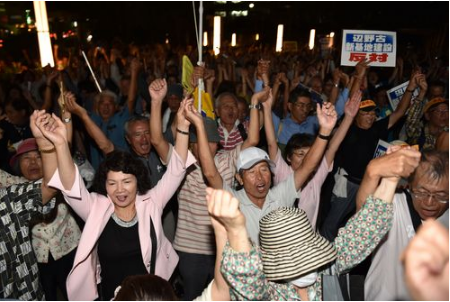
September 21, 2016 Ryukyu Shimpo
In a lawsuit brought by the Japanese national government against the Okinawa prefectural government over Okinawa Governor Takeshi Onaga’s cancellation of a permit to reclaim land in Henoko, Nago City, the presiding judge ruled it illegal for the governor not to abide by the rectification order. At Kenmin Hiroba in Naha on September 21, All Okinawa Kaigi (All Okinawa Coalition) held a protest rally against the court decision. According to the organizer, about 1,500 people gathered and proclaimed that Okinawa would win at the Supreme Court.
Co-representative of the organization and Nago Mayor Susumu Inamine said, “The ruling appeared to copy what the Japanese government claimed, ignoring the public opinion and the history of Okinawa. We will continue to battle at the Supreme Court. I will make sure that today is the day we keep fighting to secure peace for Okinawa.”
Governor Onaga said, “The ruling just repeated what the central government claimed on the issue, saying, ‘The Henoko relocation is the only solution.’ I was flabbergasted how unfair a decision the judge could make by toeing the line of the current policy-maker. I hope that the Supreme Court will make a fair and sound judgement.”
(English translation by T&CT)
Go to Japanese
September 21, 2016 Ryukyu Shimpo
On September 19 at the United Nations Office in Geneva, Switzerland, the International Movement Against All Forms of Discrimination and Racism (IMADR) made a statement delivered by its representative Taisuke Komatsu at the UN Human Rights Council. In the statement the IMADR called on the government of Japan to fully respect Okinawans’ freedom of expression in their protests against construction of US military facilities such as those being built in Henoko, Nago, and Higashi Village, Takae.
The statement delivered by the IMADR was a joint statement with international human rights NGOs Human Rights Now and Franciscans International. It pointed out that, “The large presence of the foreign [U.S.] military has caused a countless numbers of human rights violations, including sexual violence against women and girls.” The NGOs also criticized that despite Okinawans’ opposition, the government of Japan has been advancing the plans to construct new U.S. military facilities in Henoko and Takae.
During the IMADR statement, Komatsu said that the security company employed to work in Henoko by the Okinawa Defense Bureau compiled a list of protesters containing their personal information. The Japanese government denied its involvement and stated that no investigations will be conducted. In regards to newspaper reporters being forcibly removed by riot police officers in Takae, Komatsu went on to mention that, “Press freedom is under threat in Okinawa.”
The government of Japan exercised its Right of Reply to the joint NGO statement. This said in part that the construction works in Okinawa are being carried out with the consent of local governments, with the landfill permit, and in accordance with laws and regulations. In addition, it insisted that, “The government has and will continue to take appropriate measures in accordance with laws and regulations.
At the United Nations Office in Geneva, Komatsu told Ryukyu Shimpo that even though the joint statement had provided concrete examples of humans rights violations like the monitoring list from Henoko and oppression of the media, the government of Japan did not refute those points in an upfront manner.
(English translation by T&CT and Erin Jones)
Go to Japanese
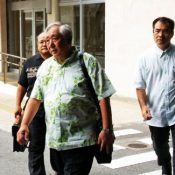
September 23, 2016 Ryukyu Shimpo
At 1:30 p.m. on September 23, the Okinawa prefectural government appealed a ruling by the Naha branch of the Fukuoka High Court that judged Governor Onaga’s cancellation of approval to reclaim land to be illegal. The ruling was the result of a lawsuit brought by the national government against Okinawa concerning Onaga’s cancellation of approval to reclaim land in Henoko, Nago, wherein the government claimed that it was illegal for Onaga to cancel the permit. If the Supreme Court accepts the appeal and a trial commences, a final verdict is expected to be reached by the end of this year.
The deadline for the Okinawa prefectural government to submit a statement of grounds for appeal is October 3.
If the Supreme Court sides with the Okinawa prefectural government, Okinawa will not be required to obey the “rectification order” issued by the government demanding that the approval be reinstated, and the cancellation will maintain its force. If Okinawa loses the case, the prefectural government will obey the rectification order and reinstate the approval.
However, the Okinawa prefectural government maintains that even if Okinawa loses the case and the approval regains force, its stance of using “every available means” to prevent the Henoko base construction will not change, and the future of the base relocation issue remains unclear.
(English translation by T&CT and Sandi Aritza)
Go to Japanese
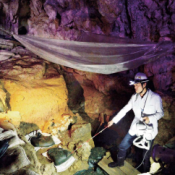
September 20, 2016 Ryukyu Shimpo
At the Sakitari cave (survey site 1) in Nanjo, Okinawa where the world’s oldest fishhooks were unearthed, other artifacts including roughly 10,000 Japanese mitten crab claws were also found. The Japanese mitten crab is related to the Chinese mitten crab, which is known as a delicacy. Many giant mottled eel bones, “irabucha” (knobsnout parrotfish) bones and other fish bones were also found. Knobsnout parrotfish is known to be delicious eaten raw as sashimi. It has been said that it was likely difficult to live long-term in an island environment like Okinawa with limited resources, but these discoveries show that humans made a living through fishing for more than 20,000 years. Masaki Fujita of the Okinawa Prefectural Museum & Art Museum, a specialist in physical anthropology, who was in charge of the survey, says that people then appear to have led a surprisingly gourmet lifestyle.
Judging from the size of the excavated crab claws, the crabs’ shells were likely 8 centimeters wide. This is the size of the crabs when they are at their largest, right before they lay their eggs in autumn. After the eggs hatch in the ocean, the baby crabs grow as they swim up the river, then head toward the ocean to spawn. Fujita surmises that ancient fishermen aimed to catch the crabs right at the season when they were fullest with meat and innards.
Because the size of the crabs alone does not provide strong enough evidence, the survey also focused on “kawanina” freshwater snails that were excavated at the same time. The proportion of oxygen isotopes in the snail shells changes in accordance with increases and decreases in water temperature. By analyzing the shells, it is possible to estimate the season in which they died—that is, in which they were caught and eaten. An analysis of the excavated snail shells showed that of 28 shells for which data reflecting a season was obtained, 19 were caught in autumn, eight in summer, and one in winter.
“The Japanese mitten crab is nocturnal, so people would have come to live in this cave every autumn, caught crabs and snails at night, and eaten them,” said Fujita, appearing confident in his hypothesis.
Until now, the oldest known fishhooks were ones made of shells discovered at the Jerimalai site in East Timor. They were estimated to be between 16,000 and 23,000 years old, but the exact date was unspecified. In Japan, the oldest known fishhooks were ones uncovered at Natsushima Kaizuka in Yokosuka, Kanagawa, which are estimated to be from the Jomon era, between 9,000 to 10,000 years old. There was previously no material suggesting that people were engaged in fishing in the Paleolithic era.
“Now when we imagine the lives of Paleolithic people, we can also imagine them enjoying fishing by the ocean or river. They could have eaten the same things we ate today and enjoyed the same delicious taste,” Fujita said with a smile.
Terms: Paleolithic era and calibrated age
In Japan, the Jomon period, called the Kaizuka period in Okinawa, began 16,000 years ago during the Neolithic era. The time before the Neolithic era was the Paleolithic era, which is known in Japan as the Preceramic period. Radiocarbon dating is used to estimate the age of artifacts from the Paleolithic era, and a calibrated age is now also displayed, being estimated by correcting the age obtained by radiocarbon dating using methods such as verifying the growth rings of plants. The calibrated age is a larger number than the age obtained using radiocarbon dating, and is closer to the actual age of the artifact.
(English translation by T&CT and Sandi Aritza)
Go to Japanese

September 20, 2016 Ryukyu Shimpo
The world’s oldest known fishing hooks from about 23,000 years ago were discovered at Sakitari Cave in the Valley of Gangala in Nanjo City, Okinawa. An infant’s bones from about 30,000 years ago were also found at the site. These are the second oldest human bones discovered in Japan, after bones of the Yamashita Cave People from around 36,500 years ago. Furthermore, it has become clear that people of the Paleolithic Era came to catch animals from oceans and rivers for food without interruption beginning more than 30,000 years ago through the remaining 20,000 years of the Era. It used to be said that it is unclear whether or not Okinawa had a unique culture during the Paleolithic Era even though skeletons of the era had been found. However, this discovery shows that not only did present-day Okinawa have its own civilization in the Paleolithic Era, but also lends clarification to the culture of Japan during that period.
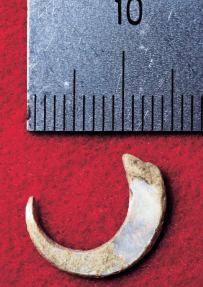
One of the world’s oldest discovered fishing hooks from about 23,000 years ago, which was unearthed in Sakitari Cave in Nanjo City, Okinawa.
The Okinawa Prefectural Museum and Art Museum has been cooperating with Nanto Bank, which manages the Valley of the Gangala, on a study there since 2009. On the 17th of this month they made the discovery public.
The fishing hooks are made out of sea snail shells and measure 1.4 centimeters across. The ends of the hooks were polished to become gradually sharp. In addition to the shell-made fishing hooks, bits of sandstone that appeared to be used to polish the hooks were found in the same geological layer. The hooks were discovered in 2012 and carbon-14 dating revealed the period during which these were used. Incomplete pieces of hooks were also unearthed.
Judging from the artifacts found, the civilization of the time made seashell spatula-like tools, shell beads, and various implements and decorations formed from sandstone.
By analyzing the large quantity of Japanese mitten crab claws and freshwater snail shells discovered, it seems that people of the time knew that the crabs mature in autumn, and chose to collect and eat them in-season.
Visiting researcher at the Research Institute of Okinawa Prefectural University Susumu Asato, who specializes in archaeology and is also the former director of the Prefectural Museum and Art Museum, said that the roots of humanity in Okinawa tracing as far back as the Yamashita Cave People have become clearer. With anticipation for the study making even more progress, he mentioned, “The relationship between the Paleolithic Era and the shell heap culture has gradually become apparent.” Results of the study were published in the US journal Proceedings of the National Academy of Sciences (PNAS), and are available online. In addition, the Prefectural Museum and Museum of Art will open a special exhibition starting on November 15 called the Palaeolithic Age of Okinawa to display relics that the excavation has unearthed.
Sakitari Cave
The cave is located in Maegawa, Tamagusu Village in Nanjo City, about two kilometers from Minatogawa Fissure where the Minatogawa People skeletons were found. Excavation by the Prefectural Museum started in 2009. Up to now, one nearly complete human skeleton from more that 9,000 years ago has been discovered there.
(English translation by T&CT and Erin Jones)
Go to Japanese
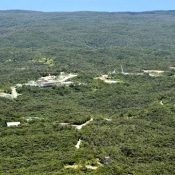
September 15, 2016 Ryukyu Shimpo
The meeting of the International Union for Conservation of Nature (IUCN) that was held in Hawaii at the beginning of the month focused on the issue of invasive species. During the meeting the IUCN adopted a recommendation on protecting Okinawa Island against invasive species. The recommendation suggests that hauling soil to the planned site for construction of a base at Henoko should be halted, due to the concern that invasive species may be within the soil used for land reclamation work.
Yambaru National Park will soon be established, the newest following Kerama Shoto National Park, and Ishigaki-Iriomote National Park. The Japanese government highly values the ecosystem that supports precious wildlife living and breeding on these islands. As such, Japan is aiming to have the Yambaru woods along with Amami Oshima, Tokuno Island, Iriomote Island designated as a UNESCO World Natural Heritage Site under the title Amami Ryukyu in 2018. However, the U.S. Northern Training Area is a bizarre environment demonstrating mixed efforts of military exercises and environmental conservationism. NGOs for environmental conservation evaluate with concern that Amami Ryukyu is an unrealistic candidate for a World Natural Heritage Site under the current limits and criteria.
Mariko Abe of the Nature Conservation Society of Japan pointed out in regards to the Yambaru woods that a national park is decided by the country, but designation as a World Natural Heritage Site is judged on harsh worldwide standards.
In contrast to the IUCN, Mariko Abe mentions, the World Heritage Committee of UNESCO’s official consultative body evaluates in technical terms if a site fulfills natural heritage criteria. Abe thinks that Amami Ryukyu gaining designation as a World Natural Heritage Site may only get more difficult if the Japanese government continues to force through base construction, the way it has ignored the last four IUCN recommendations.
Yoshikazu Makishi of the Okinawa Environment Network said that, “the Ministry of Defense and Ministry of Foreign Affairs are pressing forward with actions that hurt the environment, while the Ministry of the Environment calls for environmental protection.” He thinks that the Japanese government’s internal contradictions are not common knowledge, worldwide.
Should construction of helipads in the Northern Training Area be completed, the noise from Osprey and other US military aircraft will resound through the Yambaru woods. Makishi thinks that it would be impossible to call this a wildlife paradise with all the noise. He called for expansion of the special protection zone that does not allow small-scale development or environmental destruction.
Yambaru National Park
Under the Natural Parks Act, the Ministry of the Environment designates and manages boundaries of the Yambaru National Park. The goal of the park is to protect one of the largest subtropical evergreen forests within Japan, and the many rare species that call the ecosystem home. The Yambaru region that extends throughout the villages of Kunigami, Higashi, and Ogimi, and is comprised of about 13,700 hectares of land and about 3,700 hectares of sea. Okinawa Kaigan Quasi-National Park is also incorporated within Yambaru National Park.
(English translation of T&CT and Erin Jones)
Go to Japanese
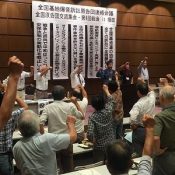
September 18, 2016 Ryukyu Shimpo
The National Liaison Council of seven groups of plaintiffs filing lawsuits over noise pollution from military bases held its 4th general meeting on September 18 at Akisihima City Hall in Tokyo.
The council adopted a resolution to oppose military bases’ violation of human rights, peace and democracy. The resolution claimed residents who were protesting against construction of U.S. helipads in the Northern Training Area in Takae, Higashi, were attacked violently by the government.
The resolution, referring to the government deploying more than 500 riot police and blocking a prefectural road, condemned the hardline response as ” an act of violence”. It claimed the government was acting under martial law without providing any legal basis for their action.
Touching on a case where reporters were forced out and placed under restraint temporarily, the resolution indicated that police power was being used to limit freedom of the press.
The resolution also criticized the government’s stance on forcing through the plan to build a new U.S. base in Henoko, Nago, as part of the relocation of the Futenma airfield in Ginowan.
The resolution will be sent to the government.
Tokio Kaneko, the representative of the national liaison council, said in a speech, “We are struggling against our huge government and the government of the United States, which is bigger than our government and has more power. We, the groups of plaintiffs must unite strongly now more than ever.”
(English translation by T&CT)
Go to Japanese
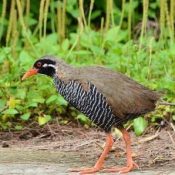
September 15, 2016 Ryukyu Shimpo
The Japanese government has designated 16,300 hectares of forest covering the villages of Kunigami,
Higashi, and Ogimi in the northern part of Okinawa Prefecture as its 33rd national park. Named Yambaru National Park, its designation as a new national park became official following the designation of the Kerama Islands as national park. Representatives of the three villages celebrated the designation by putting up banners at municipal offices.
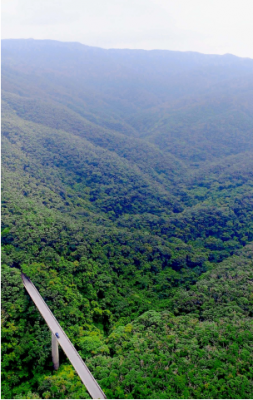
The forested Yambaru region is one of the largest subtropical evergreen forests in Japan home to endemic and rare animals and plants. In Kunigami Village on September 10 (Photograph taken by Yasuhide Matayoshi through micro wireless helicopter)
The unique park sits in the forested Yambaru region, one of the largest subtropical forests in Japan, where endemic and rare plants and animals harmoniously inhabit a diverse ecosystem. A project to review national parks, implemented in the fiscal year of 2015, deemed the region “an outstanding representation of our country.” The government aims to register the Amami and Ryukyu islands on UNESCO’s World Heritage sites. By designating the Yambaru region as a national park, the government has reaffirmed the cause of environmental conservation.
(English translation by T&CT)
Go to Japanese

September 18, Ryukyu Shimpo
Masatoshi Inafuku reports from Rio de Janeiro
On the morning of September 18, (the afternoon of the same day in Japan), the last day of competition in the Rio de Janeiro Paralympic Games, Japan won the bronze medal with a 52-50 win to Canada in the third place playoff in wheelchair rugby.
It was the first time for Japan to win a medal in wheelchair rugby.
Shin Nakazato and Seiya Norimatsu, from the Okinawa Hurricanes team based in Okinawa, contributed to the victory.
Nakazato, who lives in Urasoe City, is sponsored by Adidas Japan and Norimatsu, from Kumamoto, is sponsored by SMBC Nikko Shoken.
(English translation by T&CT)
Go to Japanese

September 14, 2016 Ryukyu Shimpo
On the morning of September 14, Okinawa Governor Onaga met Secretary-General Toshihiro Nikai of the Liberal Democratic Party of Japan (LDP) during his visit to Okinawa, at the Okinawa Prefectural Office. Onaga said, “Okinawan and Japanese governments have strained relations on U.S.military base issues. I would like the LDP side to respond to the difficult situation Okinawa faces, and ensure the discussion on the issues is carried out smoothly.” Onaga handed Nikai a paper containing various demands, including cancellation of the Henoko relocation plan.
Nikkai answered, “Although we face a lot of difficulties, I believe we can overcome them. Considering Okinawan people have contributed to the security of Japan, I think it is our turn to return the favor.”
In the paper, Okinawa called on the Japanese government to 1) secure the Okinawa promotion budget, 2) amend the tax system. 3) cancel new U.S. base construction in Henoko, move Futenma Air Base outside of the prefecture, return the land occupied by the base as soon as possible, and remove the danger posed by the base, 4) expand berths for cruise ships, 5) upgrade soccer stadiums for J1 league 6) take measures against traffic gridlock, and 7) support national health insurance projects for municipalities.
Prior to the meeting with governor Onaga, Nikai met representatives of Okinawan economic organizations. Nikai then had a dinner with Onaga and others, visited a new berth for cruise ships in Naha Port, Onoyama Athletic Park before returning to Tokyo.
(English translation by T&CT)
Go to Japanese

September 16, 2016 Ryukyu Shimpo
At 2 p.m. on September 16, presiding judge Toshiro Tamiya handed down a verdict in a lawsuit brought by the Japanese national government against the Okinawa prefectural government over Okinawa governor Takeshi Onaga’s cancellation of a permit to reclaim land in Henoko, Nago City. In filing the lawsuit, the national government argued that it was illegal for Governor Onaga not to obey a “rectification order” by the government demanding that he undo the cancellation of the permit. Judge Tamiya accepted the government’s argument and ruled it illegal for Governor Onaga not to abide by the rectification order.
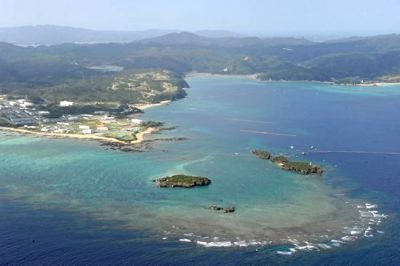
Oura Bay and Camp Schwab at Henoko, Nago, where the governments of Japan and the United States plan to build a new U.S. airfield.
This ruling was the first to be made by a court in relation to the Henoko base construction issue. The ruling will inevitably impact future discussions concerning the relocation of U.S. Marine Corps Air Station Futenma. The Okinawa prefectural government plans to appeal the ruling, whereupon the legal battle over the permit cancellation will be brought to the Supreme Court.
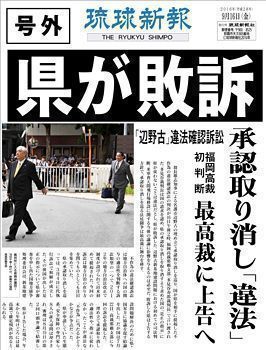
(English translation by T&CT and Sandi Aritza)
Go to Japanese














 Webcam(Kokusai Street)
Webcam(Kokusai Street)


